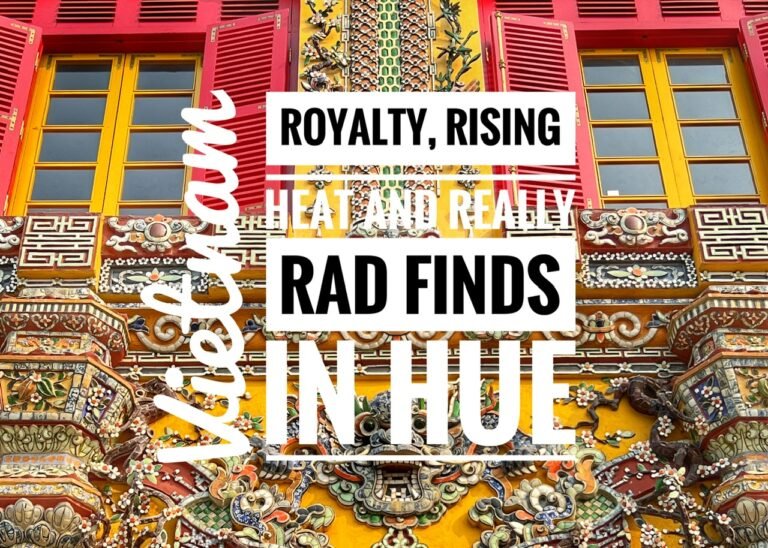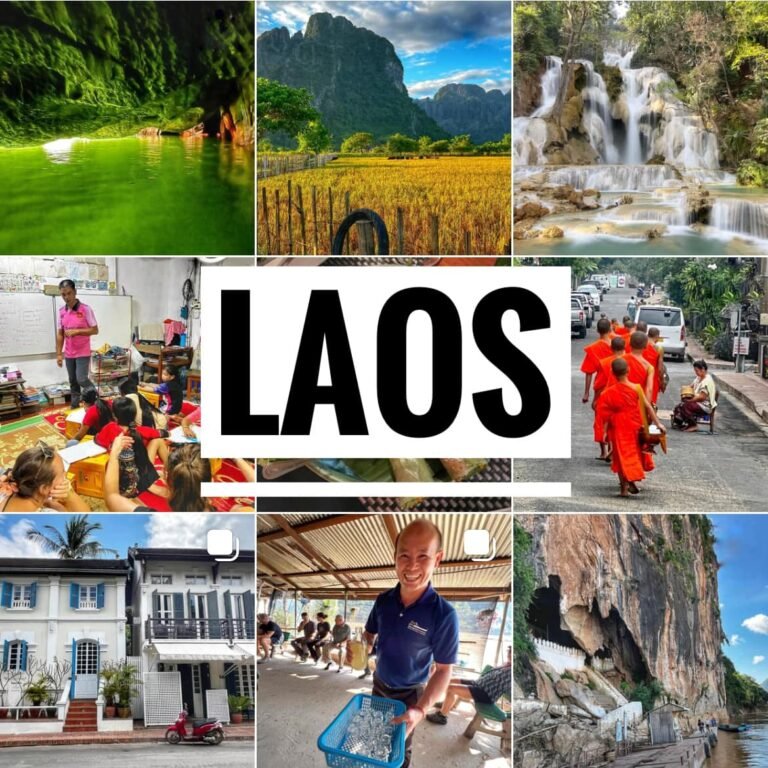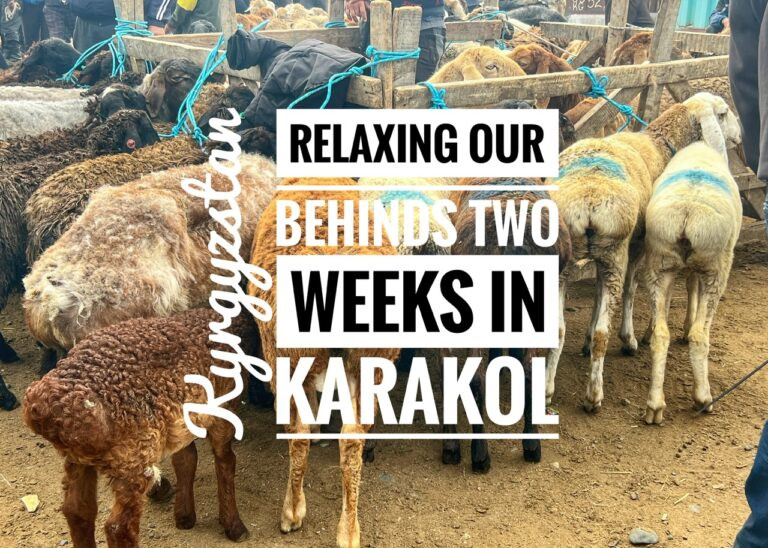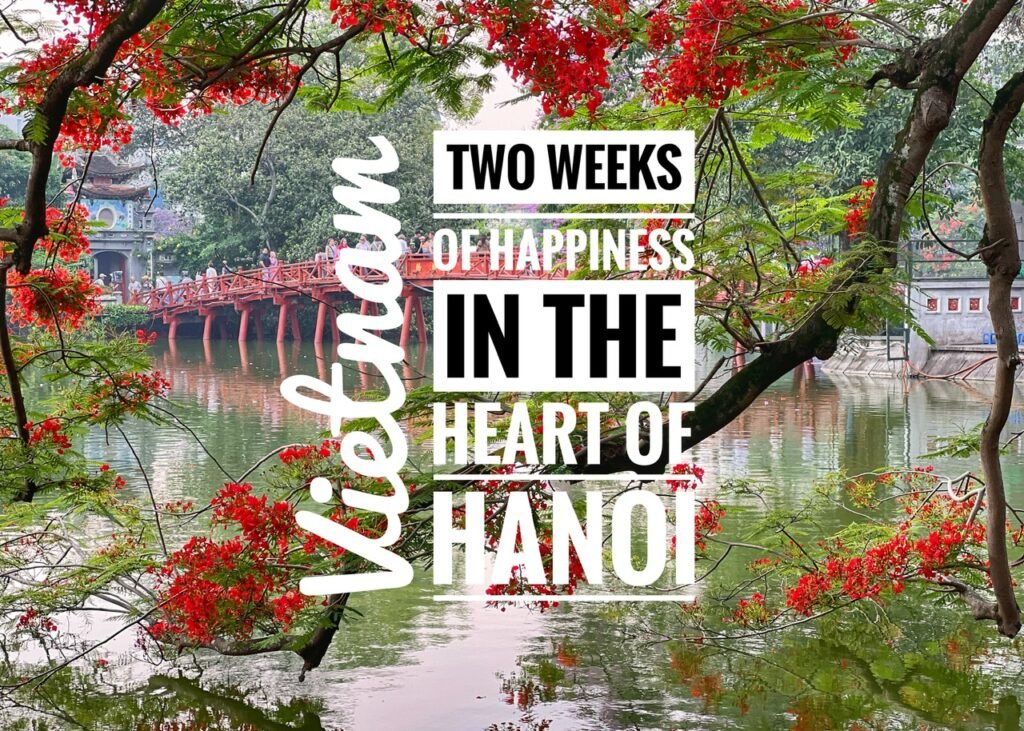
Our Apartment Accommodation(s)
Yes, we finally had real apartments and oh, did we need this downtime more than we thought. It only took one night in our super quiet(!) and cozy apartment to know we were gonna like Hanoi. Our first of two apartments $26/night on Booking was on the south end of Tây Ho, or West Lake and we were about a 20-30 minute walk from the old quarter. On the 8th floor, it had a private elevator, overlooked a green space and red-roofed buildings, and was the first true apartment we’ve had in Vietnam. This means a closing bedroom door and a real (comfortable) couch!! Whoohoo! Somewhere to sit besides the bed! It’s truly the little things that elate us!!
To be honest, other than in the big cities, apartments like this were been pretty hard to find in Vietnam, especially at our price point. We’re hoping the recent Vietnam visa extension from 30 to 90 days, will make the locals realize the demand.


The view from our upper-floor balcony hosted a mish mash of roof colors. The canal down below was also charming to look out, but undoubtedly polluted and even a bit stinky. Fortunately the fragrances did not waft up to our level.


Our kitchen and living room, which included a sharpened knife and a spatula, so pretty much a traveler’s dream. Definitely a perfect place for some cooking, and some recovery.



The bathroom had a proper shower AND a tub!!! The bedroom was super dark, super quiet and super comfy. Swoon. Plus, a washing machine!


We even had a security guard named Pho (foe) not (fuh) like the soup who escorted us up on our private elevator!! It’s safe to say we knew more Vietnamese than he knew English.

Speaking of soup, our first meal out in Hanoi was a bowl of Bun Rieu Cua, a tomato-based crab noodle soup with tofu. ($1.25) Sooo delicious!! Cities do have their appeal…
For our last week in Hanoi, we settled into a different Airbnb apartment further up Hồ Tây (West Lake,) which was a much longer walk to the Old Quarter. While the first apartment at the south end of West Lake was great for being a tourist, this one, for us is much more suitable for living longer term and when we come back to Hanoi for a month, we will definitely choose to live here. And yes, we said “when!” We surprisingly loved Hanoi this much. 😃
The area is wonderful…green, some lovely architecture, quiet where you need it, a great walking path along the lake, gyms, tons of shops and restaurants, and a 25-minute walk to a REAL supermarket and megamall, the Korean wonderland chain called Lotte.


Our second place was also very comfortable, a one bedroom-ish/studio. Basically the bedroom was separated by a glass door. Oh, how the Vietnamese love their glass. ($25/night on Airbnb.) We again had a real couch and coffee table which meant it felt like a home and we were happy.
Our bed was comfortable, but the pillows a bit flat. This is surprising because almost all pillows we’ve had in Vietnam have been good. Fortunately, we had our Nemo travel Fillos, which lift the pillows to a height we desire. Still a must in our backpacks.


Our kitchen. It had enough sharp knives to open a butchery, but no small knives for, you know, a mangosteen. Good thing we carried along our little paring knife throughout the country. We also had a cutting board, and three pan choices so, in short, we were loving cooking again. The final amenity was a friendly congregation of ants, that seemed to love the wooden spatula, despite the fact we scrubbed the hell out of it several times. Not sure what was so tasty on it that they can’t seem to move along?! 🤣


Another bathroom with another giant tub, something we haven’t seen anywhere else in the country. So, I guess we’ll bask in there while chowing down on our last baguettes for awhile and thank the French for leaving something decent behind in their attempted acquisition of the country. Another anomaly…a clothes dryer?! What?!?! 🤩

Out our balcony you can see a smaller lake. The platform is only about a foot wide, which is only useful if you’re a smoker, or are getting wooed by a Romeo from below. In actuality there is no Romeo. Instead, somewhere down there lives the demon of aviary existence. Yes, a rooster…who likes to start throwing a temper tantrum around 2 am continuing onward. Seriously?! Who the hell has roosters in the middle of a city of 8.4 million? The Vietnamese do. Fortunately, our host brought us a fan which at high speed mostly seemed to drown out the motherclucker.


Walking to the Lotte Mall, a massive blanket of lotus flowers, which provide a perfect splash of soothing greenery.

The beautiful path along the freshwater lake, which is sadly heavily polluted. You can tell because of the sheer number of belly-up dead fish. Still, locals seem to be fishing in it daily and many, continuing to use it as a trash pit. 😬😳

The futuristic Lotte mega mall with the biggest hypermarket we’ve seen during our time in the country was about a 25-minute walk. Although the produce markets are fantastic, quality and abundant supermarkets were definitely not one of Vietnam’s selling points. Korean-owned Lotte is a different story. We dropped $38 on our shopping trip for the week and got some things like feta cheese and garlic popcorn which made Mandy so gleeful she often shimmied when she was eating them.
Greg’s (Belated) 46th Birthday Celebration

Chúc mừng sinh nhật!! Nine days late, thanks to the illnesses and detours, but we finally celebrated the birthday of Mr. Greg, or Mr. Grey as he seems to be known in Vietnam! And, because that is the second question the Vietnamese ask after “what is your name?,” he’s also gotten the joy of announcing he’s 46 at least three times already.
We spent the day doing a little sightseeing, a little shopping, a lot of eating and of course, with a craft beer birthday cake, because he wouldn’t have it any other way….
A tasting flight at Pasteur Street Brewing was about $11. He also models his new Arcteryx hat which he got for $4.50.

An Indian thali lunch. Mmmm… ($8)

Kem Bo, or avocado ice cream and because it’s from Dalat, it’s also got cheese flake over it like sprinkles ($1) It’s still weird.


Pho Cuon dinner, a Hanoi “must try” which is pho in the form of rice paper rolls. Stuffed inside is beef and lots herbs which you dunk in a sweet fish sauce. ($3) Vietnamese dining is the best…sitting on minuscule stools on the street corner! 🥰

More faux pho, this time in the form of “Pho chua ngot”or sweet & sour “Pho Salad.” Mandy’s version was without the beef, but it included everything else…Rice Noodles, Fried Shallots, Peanuts, Aromatic Herbs, Cucumbers, lettuce and Homemade Sauce. Yum. ($1.50)
Hanoi Train Street

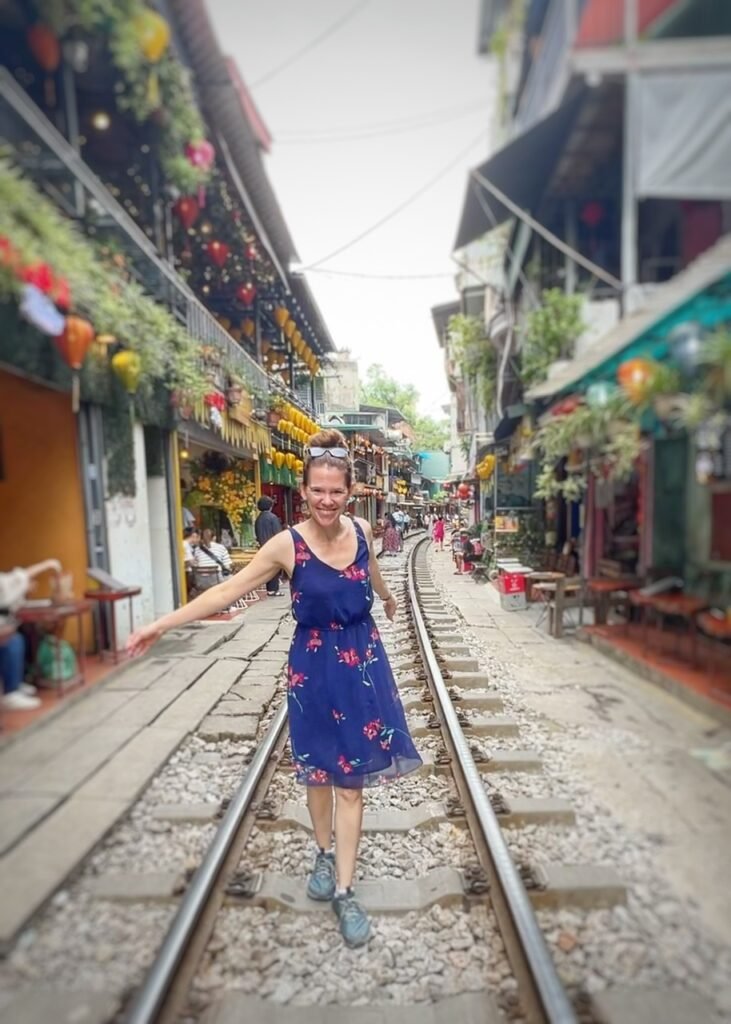
We are not usually ones to seek out Instagrammy sites, but the Train Street of Hanoi is quite a success story worth mentioning. Although there are multiple similar streets in Hanoi, this one went viral in 2019 after “Choo Choo” coffee shops started clustering on its fringe, thrusting a once deteriorating community into an overnight sensation.
The Railway Hanoi cafe spearheaded this project by winning local hearts with projects for the train-track community, including free English lessons for the kids. Locals became more involved in the new life of the Train Street and cafes began popping up in living rooms. As soon as you arrive to the street, everyone wants to usher you into their cafe for the “show,” which is an undeniably unique experience you’re unlikely to have anywhere else.
Due to safety, it has opened and closed to tourists but is now reopened with plenty of police officers who have the harrowing job of keeping everyone safe when the trains are passing through.
We read online that trains pass through: Mon – Friday: 7 pm; 7.45 pm; 8.30 pm; 10 pm and weekends at 6 am; 9 am ; 11.20 am; 3.20 pm; 5.30 pm; 6 pm; 7 pm; 7.45 pm; 8.30 pm; 9 pm; 11 pm. We obviously can’t vouch for all these times but we arrived on a Sunday at 8:45 and the 9:00 was (almost) right on time. After all, this is Vietnam not Germany. 🤣
By the way, it’s not a flowy dress, so it doesn’t count right?!


Because it was 8:50 and the train would be coming soon, we were whisked into “Ga Dong Duong” almost as soon as we turned on the street, along with everyone else. This was the very first coffee place to open nearby the busy railway road that traverses through Hanoi’s Old Quarter. The salt and milk coffees were delicious but unsurprisingly overpriced, but when overpriced means $2 instead of $1, it seems well worth it for the experience.
That said, in hindsight we wish we’d arrived a bit earlier to stake out a seat further down the tracks because the businesses there needed more customers and were just as enticing.

When the train barrels through, it’s quite a spectacle as it swallows the entire street.


The energy on the street is palpable! So vibrant!

Women selling exquisitely made pop up cards.

This street made Mandy’s inner Leo come out 😝

What a fascinating place.
Hỏa Lò Prison Relic

Another day we visited Hỏa Lò Prison Relic, which was originally used by the French colonists in Indochina for political prisoners, and later by North Vietnam for U.S. prisoners of war during the American (Vietnam) War, including noteworthy senator John McCain. During this later period, it was sarcastically nicknamed American POWs as the “Hanoi Hilton.”
It was perplexing to see the Vietnamese side of the story, which of course deeply contrasts many things we’ve heard from the American version. It was also heartbreaking to see the damage caused and read about the civilian lives ruined and lost. War is devastating, no matter how you slice it.
Most of the information in this post is from plaques at the museum. To enter the prison museum it costs 50k Dong or ~$2/person. It was mostly demolished during the early 1990s and has been a museum since. It was called Maison Centrale, or Central House, which is a traditional euphemism to denote prisons in France and is located near Hanoi’s French Quarter.


The first part of the museum focuses on the political prisoners used by the French colonists. This might explain why there’s a giant guillotine which was crazily used until 1932 inside. The particular guillotine would be brought out to a yard in front of the prison and the execution would take place in public to admonish the locals. The number of prisoners executed is not known but there were many of them, some as young as 19 years old.
The dummies used in this museum were thankfully much less graphic than the one we visited on Phu Quoc.

The dark and narrow cachot, or dungeon, was used to confine prisoners who broke the regulations of the prison. “Prisoners were kept separately, put in shackles and had to eat and relieve themselves on the spot. All the prisoners confined here were puffed with oedema, their eyes were clouded over and their bodies were covered with scabies cause by the lack of light and air.”

On the night of December 24, 1951, 16 Hoa Lo death-sentence political prisoners escaped through this underground sewer. Ugh. Can you imagine? Five of them succeeded and rejoined the resistance base to continue the struggle. Merry Christmas to them?


Depictions of the women’s prison, where children were also imprisoned alongside the mothers. Interestingly, none are shackled like in the men’s area.


Haunting cells line the corridors. Well, he looks pissed. Not that we blame him.

Moving into the jolly world of Vietnam in the 1970s…these are photos of the Haiphong neighborhood of Hanoi after US President Nixon ordered the start of Operation Linebacker I| on the night of December 18, 1972, killing 278.


Women training to fight back. And her account: “The destructive war of the United States took away both our parents. In 1967, while on the way to market, my mother gave up the bomb shelter to a child, and she was hit by a shrapnel bomb in the head and died right at Linh Ung Pagoda. At that time, I myself was also injured by a stray shrapnel bomb and had to be hospitalized. Immediately after, I submitted an application to join the self-defense team of the factory.
On the evening of December 22, 1972, at position number one of the artillery unit, myself and my fellow self-defense members shot down an F111 aircraft. On the night of December 26, while I was on duty at the battlefield, my father was killed by a B52 bomb at home!
After completing the funeral arrangements for my father, I returned to the frontline to engage in combat until the United States declared a halt to bombing in the North.”
In the other photo, children being trained on bomb recognition and first aid:
“The first lesson was how to avoid bombs. Our teacher taught us how to differentiate the direction of falling bombs. By observing their shape and flight path, we could determine where they would land. We learned when to stay still and put on our straw hats, and when to run. We learned to run in the direction that offered the highest safety. Then our teacher taught us how to administer first aid and bandage wounds, saying, ‘so that when there is no teacher around, you will know how to save your friends and yourselves.’ We started practicing bandaging, laughing and joking as if playing a pretend game. We laughed happily, but our teacher cried.”


“The United States Government carried out sabotage warfare by using their air and naval forces against the North of Vietnam from August 5th, 1964 to January 15th, 1973. Thousands of planes were shot down and hundreds of United States pilots were arrested by the North army and people. Many of them were imprisoned here.”
This photo is an example of one such pilot. Also, a flight suit used by an American pilot to control warplanes to attack North Vietnam.

These photos are of John McCain. “Soldiers and people in Hanoi saving Navy Major John Sidney McCain after parachuting into Truc Bach lake, October 26th, 1967.”
And “Vietnamese military doctor was checking the wounds of John McCain, 1967.”


A bed used to care for US POWs and “study items” for the American pilots. 🤨


The museum also showed multiple yearbook-style images of US POWs doing things like playing pool, planting trees, playing sports…

…and having a lovely Christmas dinner?! Many accounts of former pilots said things like this, “In the Vietnam War, myself and other American soldiers carried out our assigned duties. When I was shot down, I had been treated with decency. The treatment was even better than I had expected. On this trip back to Vietnam, I am delighted to see that your country is truly developing, and Vietnamese people are still kind-hearted, hospitable, and welcoming to us. The only regret I have is not having the opportunity to meet the pilot who shot down my aircraft.”

Speaking of the B-52 bombings, there is also a site in Hanoi where you can witness a more sobering reminder of the human cost of the American (Vietnam) War…the twisted remnants of a B-52 bomber shot down shortly before the war ended. The site showcases quite a contrast between the horrific reminder of what happened here on 1972, amongst a modern-day quiet community neighborhood and coffee shops.
According to Atlas Obscura, “Operation Linebacker II, known internationally as “the Christmas Bombing”, was a bombing campaign of three thousand sorties carried out by American forces between December 18th and 29th, 1972. Intended to compel North Vietnamese leaders to sign a provisional peace agreement, Linebacker II targeted military installations in the heavily populated area between Hanoi and Haiphong. Despite the intended targets and the evacuation of nearly half a million civilians from those cities, 1,318 civilians were killed in the bombing, arousing international condemnation. In retaliation, North Vietnamese forces launched more than 1,200 missiles and shot down fifteen B-52 bombers, capturing 31 crewmen and killing many more.
While American forces had been bombing the North Vietnamese for eight years, it was thought that the Christmas Bombing would force them to sue for a peace more acceptable to the U.S. and South Vietnam.
The peace terms signed in January of 1973 differed only slightly from the terms proposed by North Vietnam before the bombing.”
Geez….Hope it was worth it. 😳
Quán Thánh Temple & Hồ Chí Minh Mausoleum


Another visit was to the Quán Thánh Temple, a Taoist temple that dates to the 11th century which is architecturally notable for its black bronze statue of Trấn Vũ, a deity of the north in Taoism, and a lavish interior. We also saw the Mausoleum of the great Uncle Ho (Chi Minh), one of the most popular tourist attractions in Hanoi.
The temple cost 10,000 Dong to enter, or about $.40. The money “goes to helping people less lucky than you.” That’s nice to hear.
The temple currently has writing in Literary Chinese, due to the adoption of Literary Chinese after Vietnamese independence from China. During the 17th century, Portuguese missionaries began to write the Vietnamese language using the Latin alphabet, which is why it has a Latin alphabet today despite being tonal like Chinese and Thai. (Wikipedia)
A strong incense permeated the entire complex.

On the lap of Trấn Vũ is a serpent and a turtle. The serpent represents wealth and the turtle represents protection. In a traditional Vietnamese fairy tale, the turtle had a powerful sword that made its way to Lê Thái Tổ and allowed the Vietnamese to win the war against the Chinese.


Taoism has been mixed with other Vietnamese religions since this temple was built, so the people who come to pray are not fully Taoist. Taoism holds that humans and animals should live in balance with the universe. They believe in spiritual immortality, where the spirit of the body joins the universe after death.

There’s a lot going on here….

A nearby park with a brilliant lotus mosaic fountain.

What looks like a dignified bank building meant to withstand floods, bombs and earthquakes 7+ is the final resting place of the great revolutionary leader and president, Ho Chi Minh, whom I’m guessing you’ve heard of.
Ironically, Hồ Chí Minh did not want a mausoleum at all. In his will, he said he wanted to be cremated and to have his ashes buried in the hills of the north, center, and south of Việt Nam. He said that he liked cremation because it was healthier than burial or a mausoleum and saved farmland. His successors did not let him have this wish. The government also pretended he died a day after he really did, because he really died on Independence Day and they did not tell anyone. (Wikipedia.)
Ho Chi Minh was known far and wide as Uncle Ho, which was meant to be endearing and beloved. So, not quite the same version of the American Uncle Sam. 🤣

The one pillar pagoda Buddhist temple was astoundingly built in 1046.


More great “Law of Karma” comic strips. They remind us of the “Goofus and Gallant” feature in Highlights magazine when we were kids. The last one is hilarious 😂 How did the early Buddhists know about the world of Tik Tokers that need to see this?!
The Food of Hanoi

Wrapping up our last week in Vietnam meant cramming in the final pho and Banh Mi’s, as well as the last Hanoi specialties, including a trip to Bun Cha Hương Liên, a place renowned not only for its Michelin recognition, but for its most famous visitors in 2016…President Barack Obama and Chef Anthony Bourdain.
You can tell a lot about a country’s cuisine in how they handle vegetarian/vegan food and Vietnam has done it very well. This one above, from Veggie Castle, was one of several vegan buffets we had in Hanoi. The quality and selection was tremendous, especially for 90k Dong or $3.50.

Buddha Hand fruits at a local market. They are like a blend of a lemon and a lime with long, finger-like segments protruding from them. While they contain no fruit or pulp, the fragrant zest is prized and can be used for several dishes, like salad dressings, marinades, baked goods, and drinks. More often though, we see it as an offering to Buddha statues, as if saying, “here’s another hand, big guy…in case you forgot yours!”
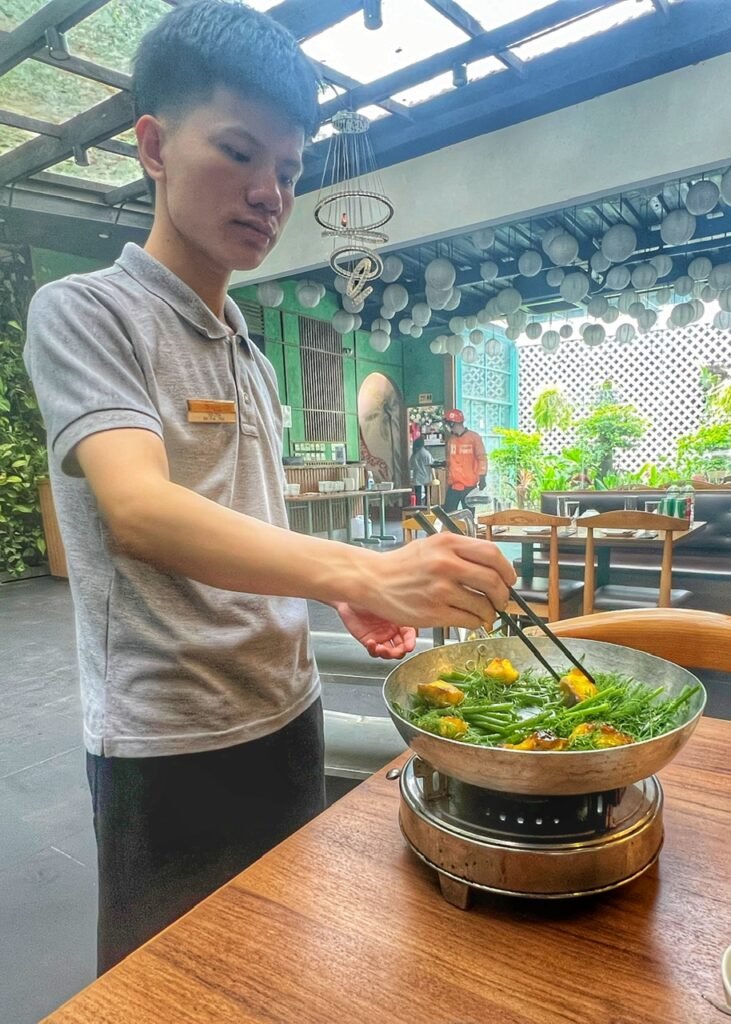

Letting a young lad whip up our first dish of Cha ca, a Hanoi signature dish, which is sauteed over a tabletop hot pot at Cha ca Ha Thanh. This is a tumeric-spiced catfish served alongside a pan of dill, basil and spring onion, with peanuts, lime, chilis and a fermented shrimp paste. Mmmm…. 😋

Our last bowl of pho in Vietnam, for $1.50. We have to admit, we were not nearly as smitten with the northern variety as the south’s, which we’ve also been served all our lives in the States. The north has wide flat rice noodles and the broth has a little less oomph. Also, on several occasions in the north we haven’t received the wonderful bowl of accompanying herbs or bean sprouts. Fortunately for our last bowl, we got lucky! Pho can be served with beef (pho bo) or chicken (pho ga.)

Last Banh Mi’s at “Banh Mi 25” were some of the best we had. Two beers and two sandwiches were about $5 which was overpriced but fine for a tourist zone.

Another vegan all-you-can-eat buffet.

Al Sultan was some delicious Egyptian food we tried to give our guts a break on the Vietnamese food. We had two falafel wraps and shared a Fautoush salad for about $10.

Visiting Bun Cha Hương Liên, or now commonly known as Bun Cha Obama.


As you can imagine, this no-frills eatery where Obama and Bourdain filmed “Parts Unknown” in 2016, has become quite popular.
But the prices are still totally reasonable. They now offer a Combo Obama, which includes a bowl of Bun Cha, a fish roll, and a Hanoi beer for under $5.

Bun Cha is another Hanoi signature dish made of seasoned pork patties, which resemble squished meatballs and caramelised pork belly slices which are served in a broth alongside rice noodles, fresh vegetables, herbs, garlic and chilies. The restaurant also offers veggie rolls for those less keen on eating piggy.


Greg getting ready to dive in with these two American icons. In Vietnamese, the photo says, “Obama meal.”
The famous table and their little plastic stools is now encased in plexiglass. According to the video, available on YouTube, Bourdain was impressed because the president had no problem handling his chopsticks. It’s very amusing to watch them clinking cheap beers, sweating with collared shirt sleeves rolled up and sharing a laugh. At one point in the video, Bourdain said, “I just wish more Americans had passports.…The extent to which you can see how other people live seems useful at worst, and incredibly pleasurable and interesting at best.” It’s a melancholy one to rewatch knowing Bourdain’s untimely death would shatter the world two years later.

What an eternal stroke of luck for these proprietors that these two decided to have a bite at their restaurant that day.
The Beautiful People of Hanoi






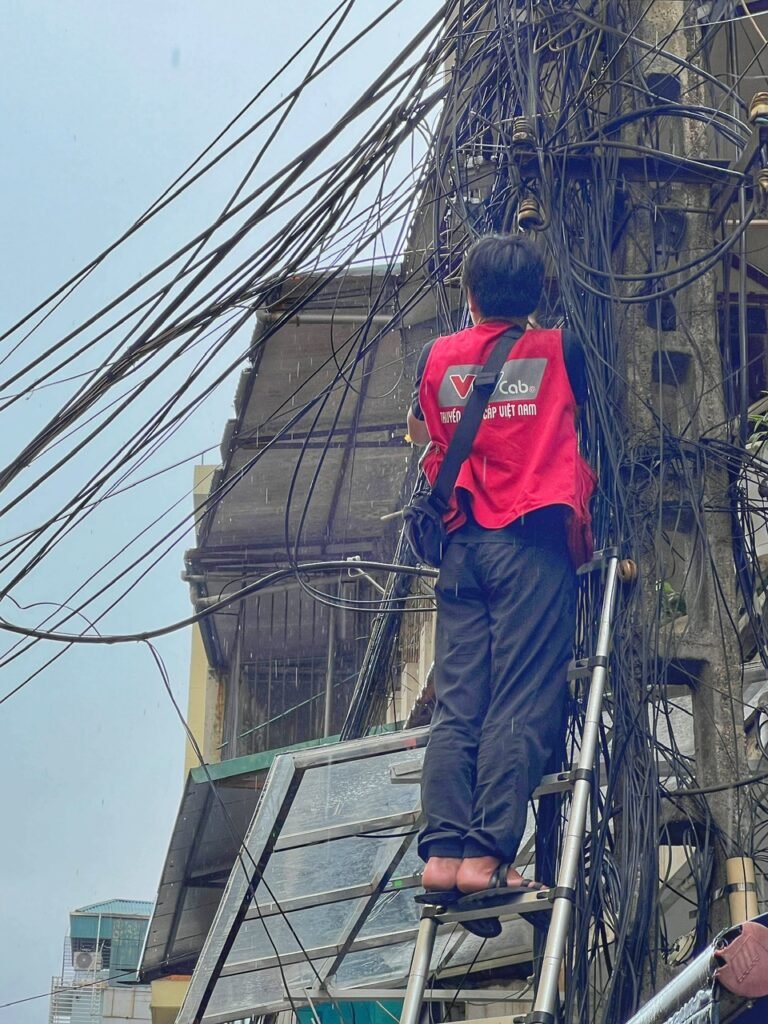


Whether selling flowers, hauling ridiculously heavy loads of goods using baskets on shoulder poles or on bicycle, washing dishes on the street, peddling fruit at seemingly all hours of the day, waiting for their next rides or trying to fix a noodled nightmare of electrical wires, one thing has been consistent throughout this country…the Vietnamese are insanely hard workers.
Technically, working hours are limited to 48 hours a week, 8 hours a day for six days a week, but many seem to pull many more.
The Stunning Scenes of Hanoi
Most people know we’re not city people, but Hanoi utterly captivated us with its photogenic allure at every turn, its striking architecture, its bargain shopping, its green and flower-embellished canopy, its mouthwatering selection of food, its easy-to-use local buses, and its overall energy, which is far more relaxed and charming than its sister Vietnamese city of Ho Chi Minh. In fact, it’s a city we see coming to again, for a much longer time than 12 days.
It owes much of its charm, which is now often crumbling, to the French colonials who undertook a major construction in Hanoi to turn it into the capital of all Indochina. But its energy and vibe belong to its lively and hardworking people. What a spectacular destination.

The “Welcoming Morning Sunlight Bridge” (yes, literally the name) guides visitors to a historic temple on a scenic lake near the Old Quarter.


Not sure if it’s like this year-round, but Hanoi was bursting with a multi-hued canopy of tree blossoms everywhere we went….it reminded us a lot of places in Mexico and we loved it. And when there wasn’t color in the trees, you could inevitably find it elsewhere.

Photographer’s fantasy.


A section of the sprawling West Lake near our first apartment and always, an abundance of coffee shops.

Dong Kinh Nghia Thuc Square is a historical relic and the bustling living room of Hanoi where locals, tourists, and scores of rickshaw drivers congregate. It’s surrounded by amazing food, an exuberant weekend night market, and some very unique architectural characteristics which can make you feel like you’re in Europe rather than Vietnam….that is, until you try and cross the street and realize crosswalk signals are just guidelines.


One of many adorable shops in Hanoi. English seems more prevalent here than anywhere else we’ve been in the country. But of course, expats, there’s also the opportunity to learn the local language…it’s easy peasy, Vietnamesey!! 🤣


A morning street scene where everyone was shoveling in their breakfast bowls of pho near our first apartment. We continued our stroll and embraced so much gorgeous green!!

One of the entrances to the historic citadel. It remarkably dates over 1000 years old.

Not a tuk-tuk. This is work cart. In fact…we were shocked to find no tuk-tuks in Vietnam. According to the Vietnam Investment Review, due to their inefficiency and environmental repercussions, as well as contribution to traffic incidents, tuk-tuk style transport has been banned in from January 2008.

But, in response, the number of motorbikes seems to be infinitely more…almost one per person at 6 million. One of many reasons, we would never drive one in this city and are shocked every time we see a foreigner playing Russian Roulette with the locals. 😳

You may not find a cheaper place in the world to buy name-brand goodies or souvenirs than in Vietnam.


St. Joseph’s Cathedral is one of those stark churches that truly lives up to its neo-gothic style. Seriously…who forgot the paint-by-numbers set?!

Tourist row in the Old Quarter. You can book any tour to anywhere in the country from here. We’ll stick with the way we do it.

Wow…I think that’s the most anorexic building we’ve ever seen.

Supposedly the streets of Hanoi are named after what sells on that particular street. According to Google Translate, “cheese tin shop” is on this street, where we actually found a bunch of sinks. Hmmm. That may be a bit lost in translation…🤣

This one, however, needs no Google. She must have been very proud to take her husband’s name. 😃💩

The entrance to the pagoda on Hoan Kiem Lake.

The entrance to the water puppet theater dates back to the 11th Century in Hanoi. It’s reasonable to attend a show at around $6, but after contemplating it, we decided it seemed a bit too Mr Roger’s to us. Maybe we missed something great though?

This Heritage house in the Old Quarter was restored in 1999 due in part to Hanoi’s sister city of Toulouse (France), as an example of an ancient Hanoian home. It represents the architecture of the Old Quarter, and is decorated to reflect ancient houses of Hanoi.


The ravishing streets of the Old Quarter transport you to another time and place.

The Old East Gate was built during the reign of King Le Hien Tong (1749). It is the only surviving gate of the 21 entrances that protected the royal family in the ancient Thang Long Citadel.

What a beautiful patchwork facade.

There is no shortage of military gear to buy in this city.

Postcard picturesque.


When it was rarely sunny, sunset walks along the lake were one of our favorite things to do, which was near the backstreets of our little island within the lake.


Also along the lake, we saw them converting many old street cars into coffee shops. So cute! Although there are still motorbikes crammed like sardines onto many sidewalks, Hanoi is definitely the most walkable we’ve experienced in Vietnam, other than the promenade in Da Nang.

When we moved to the more northern part of the lake, the K-Market became our local mini-mart for all the things we didn’t want to haul from the Lotte hypermarket.


The Trấn Quốc Pagoda is the oldest Buddhist pagoda in the city, originally constructed in the sixth century during the reign of Emperor Ly Nam De, giving it an age of more than 1500 years. We read afterward that on the grounds is a bodhi tree taken as a cutting of the original tree in Bodh Gaya, India under which the Buddha sat and achieved enlightenment. The gift was made in 1959, marking the visit of the Indian president at the time. We’re bummed we missed this!
We definitely didn’t miss the distinctive soaring stupa, however. This exquisite tower is comprised of eleven stories, each adorned with six elegantly arched doorways with white marble Buddhas inside, each more diminutive than the one below, which cast an aura of tranquility on the path to enlightenment.

Near a floating Starbucks of Vietnam called Highlands*, it’s nice to see the locals using leg power to maneuver swans around the polluted lake…better recreation than fishing!
*Highlands puts Starbucks to shame, for the record.

A collection of eye-catching street murals tell the story of Hanoi near the train tracks. A word of warning…they do sell dog meat (thit cho) nearby which was upsetting to see. It’s the only time we saw it in Hanoi.


The Hanoi Night Market fortunately was not peddling it, though we did see other body parts on sticks.


The most happening nightlife destination is Ta Hien Beer Street in Hanoi. Here’s our photo at 7:32 pm. Instead we hopped the bus, all wonderfully integrated with Google, for 8000 Dong or $.31/each to make sure we were in our jammies by 9.

